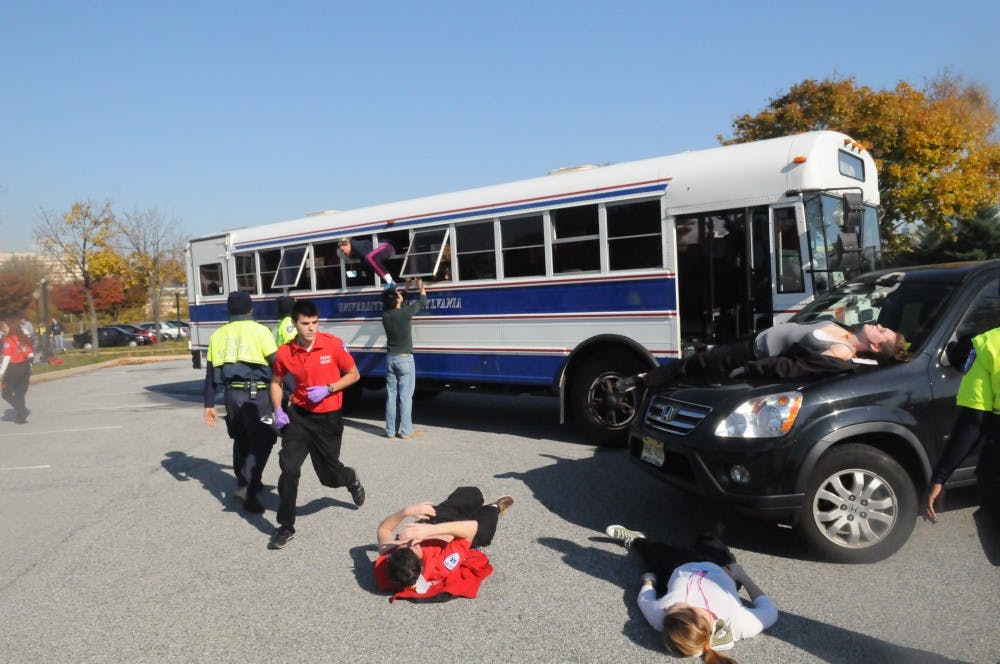
MERT members respond to simulated mass casualty incident of a car and bus collision. The injured wore makeup and fake lacerations to make the simulation more realistic.
Credit: Abigail GrahamSirens blared Sunday morning as crying and screaming came from inside a bus. Only these cries were fake.
The Medical Emergency Response Team held their third annual mass casualty field training exercise at the South Bank at 34th Street and Grays Ferry Avenue. The drill featured a fake automobile accident and diesel spill with volunteers posing as injured victims.
In this hypothetical scenario, MERT responded to a crash between a bus and a car. There was a simulated diesel fuel spill, represented by water on the ground, and injured passengers, made real by face paint, makeup and fake wound kits.
The majority of the victims were from the Philadelphia Medical Reserve Corps, a volunteer group that responds to public health emergencies. The victims portrayed the distress of the situation accurately by continuously screaming, falling down and being generally unresponsive to direction.
“Where is my son?” one woman cried. Others moaned as MERT members scrambled inside the bus, screaming when they were moved.
After an initial response by firemen, a MERT crew arrived, and a UPennAlert was sent to all MERT members calling for additional help.
Once the extra crews arrived, they participated in live training of extrication, triage and treatment of the injured. Victims were brought from the bus to treatment areas organized by severity of condition — including fatalities — and then they were prepared to be taken to the hospital.
The Division of Public Safety, AlliedBarton Security and the Philadelphia Police Department were among the other organizations present at the drill.
According to MERT Chief and College senior Dan Spielman, the drill is a way to prepare crew members for an incident MERT doesn’t see on a regular basis.
“It’s really rare to see something with this scale of patients. That’s why we do it,” he said.
MERT’s website indicates that the most typical call is for alcohol intoxication, encompassing 57.2 percent of the total, followed by altered mental states at 13.9 percent. MERT received nearly 500 calls during the 2011-2012 academic year.
MERT consists of 60 students forming crews of two or three that take turns working shifts.
Spielman said in addition to being informational for the crew members, the exercise is also for MERT leadership to practice coordinating personnel on the fly.
“[The exercise] evaluates how our response is and how quickly we can handle a large number of patients, and it’s also a great opportunity for us to work with other campus agencies,” he said.
After the drill, MERT and the other safety organizations debriefed and found ways they could improve in a real scenario.
“When the real thing happens, your practice kicks in,” said Philadelphia’s Chief of Emergency Medical Services Operations Diane Schweizer. She added the exercise was a good way to “fine tune your skills.”
MERT Athletics Scheduling Officer and College and Nursing sophomore Grace Kunas was part of the first crew on the scene and organized additional MERT resources during the drill. She said the only thing MERT crews knew was that there would be a mass casualty incident, but they did not know the scenario beforehand.
Kunas said, “The most challenging part was moving people off of the bus,” as well as dealing with low supplies.
While Spielman grew nervous because not every victim had been extricated after half an hour, he acknowledged the difficulty the crews had maneuvering within the bus.
Overall, the MERT executive board was pleased with how the drill went. “You never know what to expect with these sort of things, so I think [MERT] handled it pretty well in understanding what they were supposed to do,” MERT Disaster Response Team Officer and Engineering junior Taylor Gilliland said.
“We get better at this drill every year,” MERT Captain and College senior Emma Kofmehl said.
The Daily Pennsylvanian is an independent, student-run newspaper. Please consider making a donation to support the coverage that shapes the University. Your generosity ensures a future of strong journalism at Penn.
DonatePlease note All comments are eligible for publication in The Daily Pennsylvanian.








